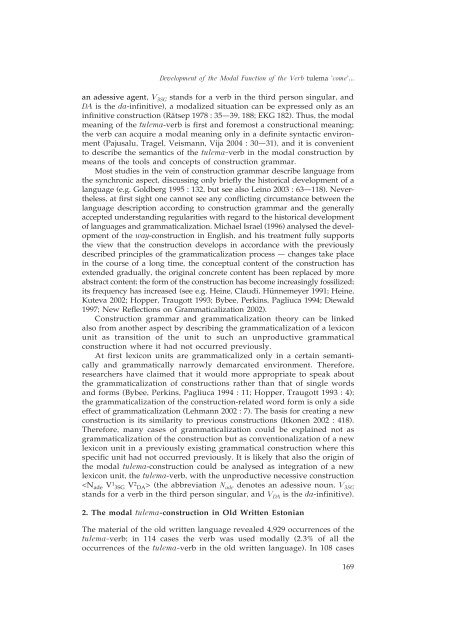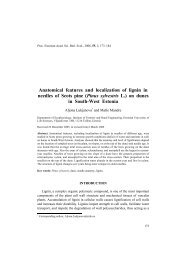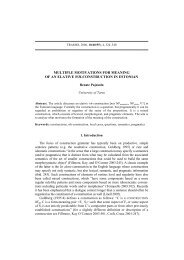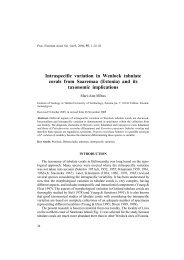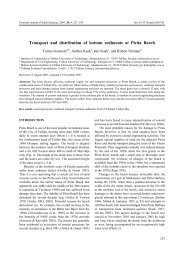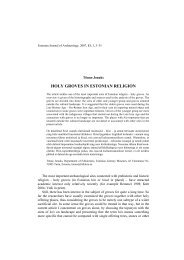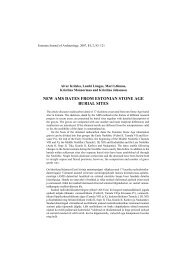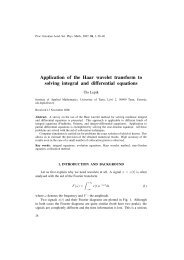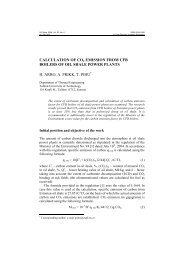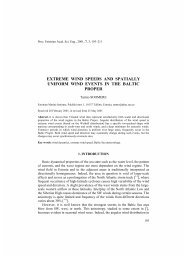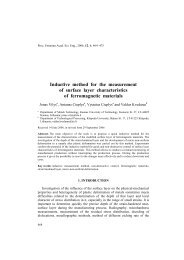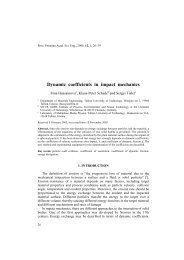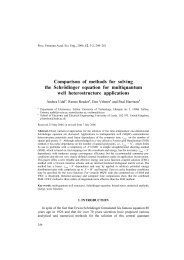PILLE PENJAM (Tartu) DEVELOPMENT OF THE MODAL ... - CEEOL
PILLE PENJAM (Tartu) DEVELOPMENT OF THE MODAL ... - CEEOL
PILLE PENJAM (Tartu) DEVELOPMENT OF THE MODAL ... - CEEOL
Create successful ePaper yourself
Turn your PDF publications into a flip-book with our unique Google optimized e-Paper software.
Development of the Modal Function of the Verb tulema ’come’...<br />
an adessive agent, V 3SG stands for a verb in the third person singular, and<br />
DA is the da-infinitive), a modalized situation can be expressed only as an<br />
infinitive construction (Rätsep 1978 : 35—39, 188; EKG 182). Thus, the modal<br />
meaning of the tulema-verb is first and foremost a constructional meaning;<br />
the verb can acquire a modal meaning only in a definite syntactic environment<br />
(Pajusalu, Tragel, Veismann, Vija 2004 : 30—31), and it is convenient<br />
to describe the semantics of the tulema-verb in the modal construction by<br />
means of the tools and concepts of construction grammar.<br />
Most studies in the vein of construction grammar describe language from<br />
the synchronic aspect, discussing only briefly the historical development of a<br />
language (e.g. Goldberg 1995 : 132, but see also Leino 2003 : 63—118). Nevertheless,<br />
at first sight one cannot see any conflicting circumstance between the<br />
language description according to construction grammar and the generally<br />
accepted understanding regularities with regard to the historical development<br />
of languages and grammaticalization. Michael Israel (1996) analysed the development<br />
of the way-construction in English, and his treatment fully supports<br />
the view that the construction develops in accordance with the previously<br />
described principles of the grammaticalization process — changes take place<br />
in the course of a long time, the conceptual content of the construction has<br />
extended gradually, the original concrete content has been replaced by more<br />
abstract content; the form of the construction has become increasingly fossilized;<br />
its frequency has increased (see e.g. Heine, Claudi, Hünnemeyer 1991; Heine,<br />
Kuteva 2002; Hopper, Traugott 1993; Bybee, Perkins, Pagliuca 1994; Diewald<br />
1997; New Reflections on Grammaticalization 2002).<br />
Construction grammar and grammaticalization theory can be linked<br />
also from another aspect by describing the grammaticalization of a lexicon<br />
unit as transition of the unit to such an unproductive grammatical<br />
construction where it had not occurred previously.<br />
At first lexicon units are grammaticalized only in a certain semantically<br />
and grammatically narrowly demarcated environment. Therefore,<br />
researchers have claimed that it would more appropriate to speak about<br />
the grammaticalization of constructions rather than that of single words<br />
and forms (Bybee, Perkins, Pagliuca 1994 : 11; Hopper, Traugott 1993 : 4);<br />
the grammaticalization of the construction-related word form is only a side<br />
effect of grammaticalization (Lehmann 2002 : 7). The basis for creating a new<br />
construction is its similarity to previous constructions (Itkonen 2002 : 418).<br />
Therefore, many cases of grammaticalization could be explained not as<br />
grammaticalization of the construction but as conventionalization of a new<br />
lexicon unit in a previously existing grammatical construction where this<br />
specific unit had not occurred previously. It is likely that also the origin of<br />
the modal tulema-construction could be analysed as integration of a new<br />
lexicon unit, the tulema-verb, with the unproductive necessive construction<br />
(the abbreviation N ade denotes an adessive noun, V 3SG<br />
stands for a verb in the third person singular, and V DA is the da-infinitive).<br />
2. The modal tulema-construction in Old Written Estonian<br />
The material of the old written language revealed 4,929 occurrences of the<br />
tulema-verb; in 114 cases the verb was used modally (2.3% of all the<br />
occurrences of the tulema-verb in the old written language). In 108 cases<br />
169


